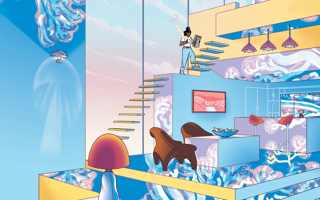The Princess Royal Silver Medals
The Royal Academy of Engineering established the Silver Medal in 1994 to recognise an outstanding personal contribution to British engineering that has resulted in successful market exploitation. In 2021, the Academy’s Royal Fellow, HRH The Princess Royal, allowed the Academy to rename its Silver Medal, to honour Her Royal Highness’s outstanding contributions as a Royal Fellow and as an exceptional champion for engineering, including as a vocal and longstanding supporter of women in engineering and science.

Heba Bevan OBE is the CEO and Founder of UtterBerry Ltd, a patented, wireless sensor system that consists of a collection of miniature, artificially intelligent, ultra-low-power sensors. The technology has been used in a variety of major national infrastructure projects including London’s Crossrail and Thames Tideway, with customers including Network Rail, London Underground, Thames Water, Laing O’Rourke, Costain, BAM, and BFK.
Heba is a businessperson and engineer with a track record of technical innovation in the areas of wireless sensor and sensor network design. She is passionate about technology design and expanding STEM education and hi-tech manufacturing in the UK. Her technical expertise includes artificial intelligence, machine learning, robotics, blockchain, optics, semiconductors, and communication systems.
After graduation Heba worked for the microchip design company ARM. She returned to academia to study low-power wireless sensor networks at the University of Cambridge, and it was during her PhD in 2013 that she founded UtterBerry.
Heba was awarded an OBE for her contributions to technology, innovation and STEM education 2018. In 2021, she received the Woman of the Year Innovation Award. Heba is committed to sustainability and the application of engineering to create new sustainable technologies in the electronics industry. She participated in COP26 and supports the government in international engagements related to sustainability.

Professor Daniel Brett and Professor Paul Shearing, UCL Electrochemical Innovation Lab
Professor Daniel Brett and Professor Paul Shearing launched the Electrochemical Innovation Lab (EIL) at University College London in 2011. The EIL is now a leading centre for technological innovation in electrochemical technology in the UK, with more than 100 researchers providing solutions that are critical to achieving net zero. It has supported the formation of several companies in the sector, including that work in low-cost fuel cell engineering, fast-charging technologies for advanced batteries and low-cost hydrogen electrolysers.
For more than a decade, the EIL has successfully operated at the intersection of university and industrial research, securing more than £45 million in collaborative R&D funding. The EIL also provides researchers with mentoring and training in commercialisation to support the market exploitation of new solutions.

Professor Brett and Professor Shearing are co-founders of The Faraday Institution, the UK’s independent institute for electrochemical energy storage research. They are members of its Expert Panel, and lead and participate in several major research programmes. As Founders of the STFC Batteries Network, they have acted as ambassadors for UK science on an international stage, and frequently advise the UK government on policy matters. As leading academics, their combined achievements have enabled widespread scientific, commercial and policy impact, exemplifying the spirit of collaboration that is a cornerstone of engineering practice.

Dr Atif Syed, CEO and Founder of Wootzano
Dr Atif Syed has a PhD in engineering and electronics focusing on developing next-generation flexible and compliant sensors. The Academy awarded him with an Enterprise Fellowship in 2018. His work resulted in the development of a new electronic skin – further developed in County Durhamheadquartered Wootzano Ltd, which he founded in 2018. The electronic skin is being used in Wootzano’s robotic fruit and vegetable packaging system, Avarai.
Fruit and vegetable packers across the world struggle to hire human workers and maintain quality consistently in an industry with razor-thin margins. Avarai uses a patented electronic skin, coupled with machine learning, electronics and custom end-effectors, which enables the system to estimate weight, cut fruits to weight and sizes, identify defects and measure quality, and pick and delicately place into punnets based on end retailer specifications. The electronic skin can be stretched at least 150% without damaging the metallic contacts on top of it. It is food-safe and uses robotic end-effectors to delicately pick and place soft fresh produce – previously a difficult task for robots to complete without bruising or damaging the food.
Wootzano now holds 25 patents covering all aspects of the Avarai robotic system. Dr Syed’s extensive expertise in electronics, nanotechnology, robotics, and artificial intelligence has led to Avarai’s integration in various other fruit and vegetable applications and gained one of the largest value contracts won by a British robotics company to date.

Dr Oliver Payton, CTO and Founding Director of Bristol Nano Dynamics and Founding Director of ImiTec
Dr Oliver Payton has developed and successfully commercialised two innovative technologies capable of mapping the invisible: the first enables the nano world to be observed with unparalleled ease and at unmatched speed; the second maps radioactive isotopes at high sensitivity over kilometre ranges. Both of these award-winning disruptive technologies have been exported all over the world.
Dr Payton’s innovation journey started as a PhD student when he developed a new form of scanning probe microscope known as a high-speed atomic force microscope (HS-AFM), used in diverse areas of engineering ranging from nuclear systems to healthcare. This overcomes serious limitations of conventional machines and allows real-time observation of dynamic nanoscale processes or the mapping of nano and microstructures over millimetre-sized areas, thousands of times faster than alternative technologies. Dr Payton subsequently held an Academy Research Fellowship that allowed him to improve the microscope to the point of commercialisation. In 2015, he co-founded Bristol Nano Dynamics (BND) as a spinout from the University of Bristol, taking on the role of Chief Technology Officer.
Following a successful medical trial with collaborators in the US, BND’s instrumentation is being developed for next-generation genome mapping. This can rapidly identify common blood and breast cancers and will be able to identify genetic diseases for which there are currently no tests.
Dr Payton has also developed a novel, remote radiation mapping system. This technology formed the basis of his second spinout company: ImiTec Ltd. The technology has since been used in several countries around the world, including over the Fukushima precinct and more recently around Chernobyl as well as on the UK’s main nuclear decommissioning site, Sellafield.
ImiTec’s radiation mapping technology can be mounted to crewed or un-crewed vehicles (ground or air based) and is capable of routinely searching nuclear sites for radiological threats, providing a first response to a nuclear emergency. More recently, ImiTec’s Autonomous Airborne Radiation Monitoring System has been used to identify rare earth and precious metal mineral veins over a range of kilometres.
In 2015, Dr Payton was awarded the National Nuclear Laboratory Impact Award and a Royal Academy of Engineering ERA Foundation Award. He has advised the Department for Business, Energy and Industrial Strategy and the Government Office for Science on the next generation of radiological monitoring technologies.
Keep up-to-date with Ingenia for free
SubscribeOther content from Ingenia
Quick read

- Environment & sustainability
- Opinion
A young engineer’s perspective on the good, the bad and the ugly of COP27

- Environment & sustainability
- Issue 95
How do we pay for net zero technologies?
Alex Keeler: Electrifying trains and STEMAZING outreach

- Civil & structural
- Environment & sustainability
- Issue 95